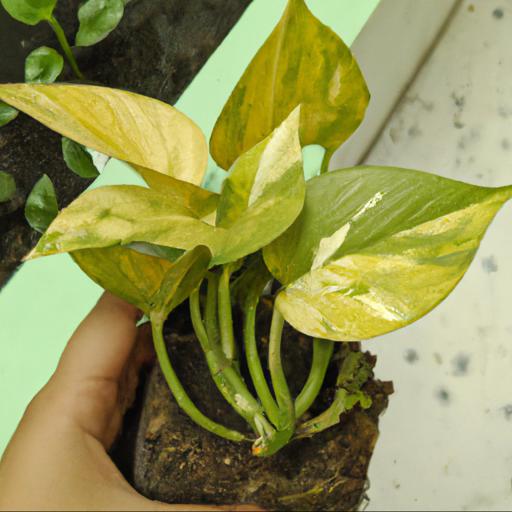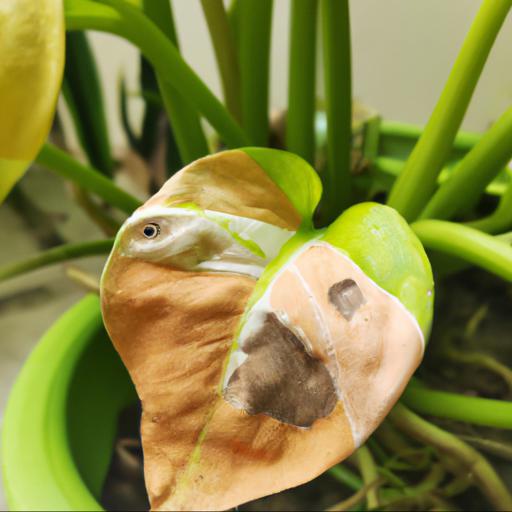Epipremnum aureum, commonly known as Devil’s Ivy, is an evergreen climbing vine that is native to tropical regions of the world. It is a popular houseplant due to its hardiness, ease of care and attractive foliage.
Its heart-shaped leaves are variegated with yellow, green and white. Devil’s Ivy is an ideal choice for those looking for a low-maintenance, attractive houseplant. It is a fast-growing vine that can be trained to grow up a trellis or along a wall.
Its trailing stems and glossy leaves also make it an attractive addition to a hanging basket. With proper care, Epipremnum aureum can thrive indoors for many years.
Benefits of growing epipremnum aureum

Epipremnum aureum is truly a marvelous houseplant that offers numerous benefits and is an excellent choice for any home. Not only is the plant incredibly elegant and low-maintenance, but it brings with it some added health benefits to those who have it in their residence. Known more commonly as a Golden Pothos, this evergreen vine and trailing plant sports attractive, heart-shaped foliage and is easy to take care of and is ideal for those who may want a plant in their home but are not fans of heavy upkeep.
It thrives under a wide variety of conditions and its versatility means it works exceptionally well when placed by a window with plenty of indirect sunlight or even when put into a darker corner. Humidity also doesn’t need to be of any concern when caring for a Golden Pothos as it adjusts quite well to varied levels of moisture content.
It can help to purify the air, contributing to a pleasant and healthy atmosphere for those living in the residence, as it is known to remove pollutants such as formaldehyde, benzene, carbon monoxide, and xylene from the environment. Not only does the Golden Pothos help to improve the atmosphere of a home, but it may even boost productivity and morale as well.
Spending time tending to and caring for a delightful potted plant can provide a great job satisfaction boost, calming the mind and allowing one to focus their thoughts. Furthermore, the Golden Pothos can create an overall feeling of wellbeing and can help reduce stress, increasing peace and happiness.
Tips for growing epipremnum aureum

Are you looking for tips to help you grow a lush and beautiful Epipremnum aureum (also known as pothos or devil’s ivy) in your garden? With a bit of care and know-how, you can have a healthy and vibrant plant flourishing in no time.
The first step in growing a healthy and thriving Epipremnum aureum is to ensure it is planted in the right place and given the right care. Epipremnum aureum needs well-draining soil and bright, indirect light. Be sure that the soil is kept moist but never soggy, and it’s a good idea to feed the plant during the growing season with an all-purpose fertilizer.
It’s important to adjust the temperature and humidity levels for your pothos accordingly. Optimal growing conditions for the Epipremnum aureum are a temperature between 55-75°F and relatively high humidity. To raise the humidity in its vicinity, you can mist the leaves and occasionally place the pot on a tray of wet pebbles.
Keep in mind that the plant should be repotted every other year or so, as well as pruned or trimmed to maintain its shape and size. Finally, it is essential that you pay attention to pests and diseases.
Always inspect your Epipremnum aureum for any signs of infestation, such as discoloration of the leaves, and take immediate action if you spot any. Diseases such as leaf spot and root rot can be easily prevented by ensuring proper drainage and never overwatering the plant.
These simple tips can help you grow a beautiful Epipremnum aureum with minimal effort. With the right care, your pothos will soon be flourishing in your garden.
Common problems with epipremnum aureum

Epipremnum aureum, more commonly known as ‘Devil’s Ivy’, is an evergreen, climbing vine native to the tropics of southeastern Asia. It’s unique foliage and ease of care has made it one of the trendiest plants in both indoor and outdoor home gardens.
While this type of plant requires relatively little care compared to others, it is still prone to several common problems. The most common issue when caring for Epipremnum aureum is over fertilizing. This is a problem when the plant is provided with more nutrients than it is able to process or absorb.
The root system will become overwhelmed and can lead to a decrease in foliage, yellowing of leaves, and stunted growth. It is best to keep to the recommended fertilizer dosage indicated on the package, as too much fertilizer can also lead to chemical burn and root damage. Another common problem with Devil’s Ivy is an infestation of mealybugs.
These white, cottony pests feed off the nitrogen-rich sap and can quickly engulf the plant if not addressed. Consequently, the foliage turns yellow, wilts, and the overall health of the plant deteriorates.
To avoid an infestation, start by wiping down leaves to prevent the bugs from attaching, and then treat the issue with insecticidal soap or neem oil. Finally, one of the least recognized problems is underwatering.
This is especially true for Devil’s Ivy, which performs best when its soil is kept lightly moist. If the plant is allowed to completely dry out, the foliage will eventually turn yellow and wilting of leaves is likely to occur. Make sure to check the soil moisture level at least once a week, and water accordingly.
Overall, epipremnum aureum requires minimal care and is generally a trouble-free plant when planted and cared for correctly. As with any plant, however, it is vulnerable to certain issues if not properly monitored and taken care of. By taking some simple steps to prevent common problems associated with epipremnum aureum, you can easily keep your ‘Devil’s Ivy’ looking healthy and vibrant.
How to care for epipremnum aureum
With a name like Epipremnum aureum, you may be forgiven for thinking that this vine looks like something out of a fairytale. However, this easy-care plant is one of the most popular indoor trailing plants and can be found in many of Britain’s homes. In this article, we’ll be looking at how to care for Epipremnum aureum.
Epipremnum aureum, often known as Devil’s Ivy, has attractive foliage with glossy heart-shaped leaves, usually in a light green shade with yellowish and cream coloured markings. Its strong climbing stems, up to 15 feet long, need help to grow on, and will usually be coiled around a support.
It’s not fussy on soil type, and can thrive indoors if given a warm and moist position, sometimes with bright indirect sunlight. For the perfect environment for your Epipremnum aureum, you should water it regularly, particularly during dry spells, and also mist the leaves with a spray bottle from time to time. Keep the soil moist and, if necessary, feed the plant with a diluted liquid houseplant fertiliser once a month.
When required, you can easily prune the stems as this plant responds well to regular pruning. This will encourage it to grow more vigorously and help maintain a healthier, more attractive shape.
Epipremnum aureum is a great low-maintenance plant and an ideal choice for brightening up dark corners in the home or for adding a little colour to office desk. With just a few simple steps to create the perfect environment, you can make sure your Devil’s Ivy stays healthy and vibrant all year round.
Our video recommendation
Bottom Line
Epipremnum aureum, commonly known as Devil’s Ivy, is a popular houseplant due to its hardiness and ability to tolerate low light conditions. It is easy to care for and can be grown in a variety of ways, including in hanging baskets or trained up a trellis.
It is a fast-growing vine that can be used to add a touch of greenery to any space. With its bright, glossy leaves, it is also a great way to bring a pop of color to any room.
FAQ
What are the common names for Epipremnum aureum?
The common names for Epipremnum aureum are golden pothos, devil’s ivy, and money plant.
How does Epipremnum aureum propagate?
Epipremnum aureum propagates through stem cuttings. Cuttings should be taken from healthy, mature stems and placed in moist soil or water until roots form.
What are the ideal growing conditions for Epipremnum aureum?
Epipremnum aureum prefers bright, indirect light and temperatures between 65-85°F (18-29°C). It should be kept in well-draining soil that is kept slightly moist but not soggy. It also benefits from regular misting.
What pests and diseases affect Epipremnum aureum?
Common pests and diseases that affect Epipremnum aureum include spider mites, mealybugs, scale insects, root rot, and leaf spot.
How often should Epipremnum aureum be watered?
Epipremnum aureum should be watered when the soil is dry to the touch, about once a week.
How can Epipremnum aureum be used in landscaping?
Epipremnum aureum, commonly known as the golden pothos, can be used in landscaping as a trailing plant or as a hanging basket. Its glossy, heart-shaped leaves are attractive and can be used to add texture and color to any landscape. It is also a low-maintenance plant that is easy to care for and can tolerate low light conditions.

